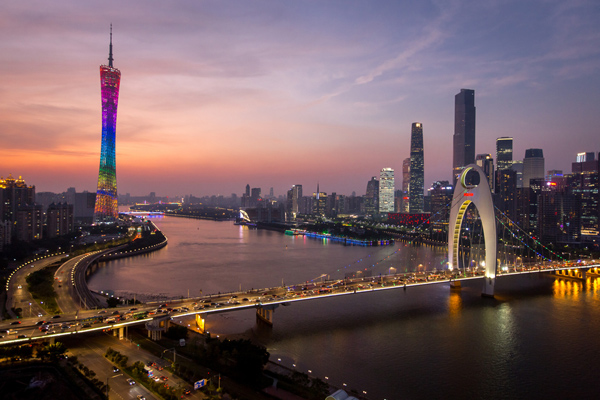Report highlights nation's top five 'cities of opportunity'
 |
|
View of the Canton tower and the Liede Bridge over the Pearl River at sunset in Guangzhou, Guangdong province, Dec 27, 2016. [Photo/VCG] |
Guangzhou, Shenzhen, Hangzhou, Wuhan and Nanjing have been ranked as the top five cities for opportunity in China, according to a report jointly launched by PricewaterhouseCoopers and the China Development Research Foundation.
The report said that technological innovations and balanced development were the keys to building "cities of opportunity".
The report provided in-depth observations on 28 Chinese business and administrative capitals-excluding Beijing and Shanghai-using several indicators.
The indicators included intellectual capital and innovation, technology readiness, important regional cities, healthcare, safety and security, transportation and urban planning. Others were sustainability and the natural environment, culture and lifestyle, economic clout, cost and ease of doing business.
Guangzhou and Shenzhen, benefiting from balanced development, took first and second place respectively in the rankings. Hangzhou ranked third, owing to its technological advantages. Wuhan, which had achieved a good balance between development and costs, was in fourth place, followed by Nanjing with its quality culture and lifestyle.
PwC China strategy consulting partner Jinn Jun said: "These cities rank in the top-five places in more than four indicators, clearly highlighting the importance of balanced and comprehensive urban development."
The report also found that the top cities in intellectual capital and innovation and technological readiness also achieved high scores in the overall ranking, a clear indication that technologically advanced cities were more likely to earn the title of "cities of opportunity".
In addition, the top-ranking cities typically performed poorly in costs and culture and lifestyle. China's "cities of opportunity" continue to face challenges when it comes to building cities that satisfy the needs of the populace and provide a high quality of life.
PwC China public policy and regulatory affairs leader and Beijing senior partner Wu Weijun, said: "Chinese large and medium-sized cities, as represented by Guangzhou and Shenzhen, have entered the Urban Development 2.0 era, where technological innovation and balanced development are key."
According to Wu, from the point of view of investors, the introduction of new technologies, attracting and developing talents, improving innovation capabilities and achieving balanced development are all ways to seize new opportunities arising from future urban development.
Lu Mai, secretary-general of the China Development Research Foundation, said: "The report shines a spotlight on the current state of the development of large cities across China. Focusing on these cities and the urban clusters around them is key to capturing the next phase of China's development."









